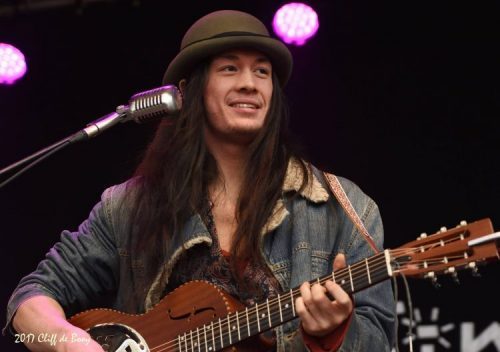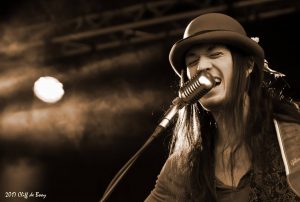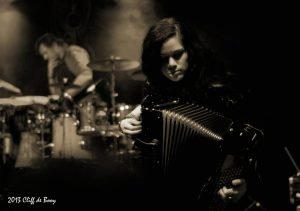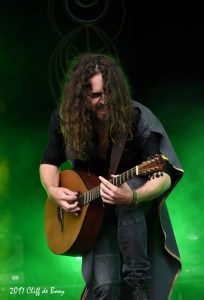
There is this Dutch saying: ‘all good things come fast.’ But I don’t think even Satria Karsono would have dared to dream that he would be rocking the Winter Castlefest stage with his own band Sunfire, only 10 months after doing his first solo concert as a support act for Thundercrow.
Nor would he have expected that ALL the major Dutch fantasy festivals would be queuing up to book his band for the 2018 season. Whether you will be visiting Elfia, Zomerfolk or Castlefest, there is no escaping the western folk sounds of Sunfire. And you might bump in to them on a lot of other Dutch festivals as well. 2018 is starting to look like a break through year for this young band.
Sunfire already visited the CeltCast living room and the song Yoyo was our February 2018 monthly marker . So it’s high time we finally introduce Satria’s music in a CD review.

We first picked up on Satria Karsono’s music when he released the mini CD Endorphine under the artist name Satria Sunfire in 2014. It is a beautiful 6 track album that showcases Satria as a gifted singer-songwriter and guitarist. His style can be described as laid back acoustic music, with a warm soulful voice and good lyrics, reminding me a bit of Jack Johnson. It kinda feels like friends sharing life stories while drinking good wine around a campfire.
Endorphine was brought out as a download album only. Although officially no longer promoted, you can still find it in the archives of the good old internet if you want to.
In February of 2017 Satria did his first solo performance at the Thundercrow release party, for their CD Drop It. He played old material from his Endorphine Mini CD and gave us a taste of the new songs that were released on Sunfire soon after. This is his first -and for the time being only- full length solo CD. Satria recorded it with the help of old friend and sound engineer Berend de Vries. But even before officially releasing Sunfire, Satria already told us he wanted to bring a band together to promote the CD and work on new material.
In the summer of 2017 Sunfire did some small shows as a full band for the first time, with Satria on vocals, guitar and percussion; Berend de Vries on (solo) guitar and Michel Beeckman on bass.
The final piece of the Sunfire puzzle fell into place when Sophie Zaaijer (Cesair, Shireen) added her violin skills to the American folk sound that was already starting to emerge within the band. The four of them adding yet another unique sound to the already so vibrant fantasy folk scene. Alternative Western folk.
Back to the CD. Reading about the short but rapid development from Satria Sunfire as a solo artist to Sunfire as a band, it’s easy to think that Sunfire the solo CD -are you getting confused already?- is just an intermediate stop, building up to the Western folk style the band have now. But that wouldn’t do the album any justice. No justice at all. So let’s talk music!
 After the intro called Intro, a short soundscape kinda thing with fragments of songs from the album setting the mood, the CD kicks of with Live Today. The first chorus, with it’s single acoustic guitar and Satria’s soulful vocals, is still how I remember him from Endorphine. But the start of the second verse changes the whole sound. Daphyd Sens and Rob van Barschot
(Thundercrow,
Omnia)
join their friend and former band mate to give the sound a cool almost Australian groove. But it’s the ’70’s electric guitar with a cool lo-fi effect on it that makes the song sound old and rugged, almost desert like. A guitar sound that reminds me a wee bit of
the Shadows
or more recently
Edwyn Collins.
To be clear. Edwyn Collins is a pop &rock and roll singer, while Satria Karsono’s solowork is singer-songwriter material with
bluegrass
and
alternative country
influences. The reference is only to illustrate that Satria and Berend used a similar guitar sound to give the Sunfire album a modern and yet old feel.
After the intro called Intro, a short soundscape kinda thing with fragments of songs from the album setting the mood, the CD kicks of with Live Today. The first chorus, with it’s single acoustic guitar and Satria’s soulful vocals, is still how I remember him from Endorphine. But the start of the second verse changes the whole sound. Daphyd Sens and Rob van Barschot
(Thundercrow,
Omnia)
join their friend and former band mate to give the sound a cool almost Australian groove. But it’s the ’70’s electric guitar with a cool lo-fi effect on it that makes the song sound old and rugged, almost desert like. A guitar sound that reminds me a wee bit of
the Shadows
or more recently
Edwyn Collins.
To be clear. Edwyn Collins is a pop &rock and roll singer, while Satria Karsono’s solowork is singer-songwriter material with
bluegrass
and
alternative country
influences. The reference is only to illustrate that Satria and Berend used a similar guitar sound to give the Sunfire album a modern and yet old feel.
This specific lo-fi sound is actually a blueprint for the whole CD. In my eyes, Live Today is also a bridge between the singer-songwriter Satria Sunfire I heard on his first mini CD and the Western folk band that Sunfire has become today
That same electric guitar starts the second song Sunfire. Satria wrote this song on an early morning, while he was sitting on his balcony watching the world wake up below him. And you feel it. The melody reminds me a lot of My World, a song by Tim Kay, that Jamie Oliver used for his Jamie at home series. It has the same laid back, comforting feel to it. Here the singer-songwriter in Satria shines, with some impressive harmonies in the later part of the song. It’s impressive to hear how high Satria’s voice can reach. Guitar and vocals, you really don’t need more to have a beautiful song.
The third song, Ghost, takes us across the water to the great plains of America for the first time. With the tender slide guitar notes, the native American influences, the flute and the lyrics reminding me of native American medicine men taking on their totem animals to fly over their native land or glide through the night like a mountain cat. It is a beautiful homage to these proud ancient people. Again with stunning vocals and harmonies building up a impressive climax.
 With Dirty James we stay in the good old US of A. In bluegrass country to be precise. This song, based on a laid back banjo riff, is the first one I heard that comes with a lyrics health warning . Don’t listen to those lyrics while you are eating. Not unless you’re on a diet that is. It will kill your appetite in seconds. Trust me.
With Dirty James we stay in the good old US of A. In bluegrass country to be precise. This song, based on a laid back banjo riff, is the first one I heard that comes with a lyrics health warning . Don’t listen to those lyrics while you are eating. Not unless you’re on a diet that is. It will kill your appetite in seconds. Trust me.But, all fun aside, it’s a cool song which shows the witty side of Satria’s songwriting skills. I’m secretly hoping he will include it in his live set again one day. Because the song is really funny and I’m actually interested what Sophie could do with the violin in it. I have this odd feeling it would be pretty surprising.
The next song I wanna pick out, Find Your Home, comes closest to the uptempo alternative western folk Sunfire is playing now. In an interview Satria told me where he wanted to go with his music. In the fantasy scene we focus a lot on European folk. Be it the Eastern European or the Celtic version. But the emigrants to America also took that music with them. In the south it evolved in what we now call country music. In the east, under the influence of the Irish and Scottish emigrants it turned into bluegrass. And it is this ‘American folk’ that Satria wanted to explore with his band Sunfire. Find Your Home has that cool uptempo western folk feel that we now know to be the typical Sunfire style.
 With A Smile For You and Little Rascal we come to the deeper emotional part of the album, where Satria really proves to be a gifted singer-songwriter.
With A Smile For You and Little Rascal we come to the deeper emotional part of the album, where Satria really proves to be a gifted singer-songwriter.
Both songs are ballads. A Smile For You again has those native American influences I mentioned in Ghost. He reaches deep inside to express the emotions that he feels seeing people hurt within these lyrics. Real goosebumps. In Little Rascal Satria shows that he isn’t afraid to put delicate subjects into his songs. It’s a homage to all the women who have lost a child before birth. Something that is not talked about a lot. A hidden grieving that he managed to put into words. Soothing. Sung as a warm embrace for everybody who had to go through this experience.
Mr Whiskers is the ideal song to follow up on all those emotions. It’s a witty bluegrass ballad about an old stray cat in a dirty old ghost town somewhere in the deep American countryside. Putting the odd smile right back on your face.
Yoyo, Celtcast’s February Monthly marker, is a bit of an odd one out on the album. With Daphyd Sens and Rob van Barschot joining in again on Slidgeridoo and percussion, it has this Australian beach feel again that we started out with on the album with Live Today. Ending our visit to the American plains and ghost towns.
Immortal then totally closes the circle on this album. Again a soundscape kinda song. Let´s say Pink Floyd meets the shadows in the Australian desert, with Satria putting his electric guitar skills to good use. Odd, eerie but beautiful. Closing a CD that opened a whole new musical world to me. A world of bluegrass, alternative country and americana, mixed with the singer-songwriter i’m more familiar with. A world that the band Sunfire is going to open up even more for us. As we speak the band is writing and recording new material for the upcoming CD, due to be released some time in the summer. I was allowed to listen to a short preview and believe me, it is gonna rock your socks off. So I’ll finish this review about the ‘old’ solo work of Satria ‘Sunfire’ Karsono with a preview of the new alternative Western folk band Sunfire. And their first single Jordan.
– Cliff
– photo’s by Cliff de Booy























